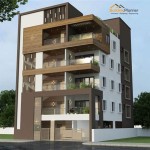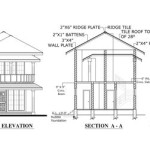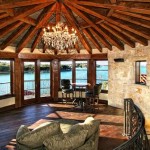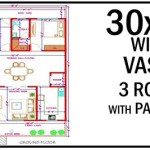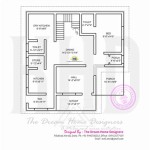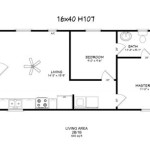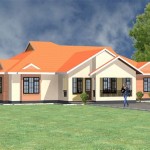North Facing House Vastu Plan 30×40: A Comprehensive Guide
Vastu Shastra, the ancient Indian science of architecture, emphasizes the importance of aligning a building's design with natural energies to promote well-being, prosperity, and harmony for its occupants. For a north-facing house with dimensions of 30x40 feet, applying Vastu principles requires careful consideration of various factors, including the placement of rooms, the direction of entrances, and the incorporation of natural elements. This comprehensive guide will delve into the key aspects of Vastu compliance for a 30x40 north-facing house, offering practical advice and insights to optimize the living space according to Vastu principles.
The north direction, according to Vastu, is ruled by Kubera, the deity of wealth and prosperity. Therefore, a north-facing house, when designed according to Vastu principles, can attract positive energy and financial abundance. However, incorrect implementation can lead to imbalances and potential negative impacts. A meticulous approach to planning and design is therefore crucial.
The 30x40 feet house plan often presents unique challenges and opportunities when implementing Vastu principles. Proper space management and adherence to directional guidelines are paramount for creating a harmonious and prosperous living environment. This document provides a detailed outlook on how to achieve this balance.
Entrance Placement and its Significance
The placement of the main entrance is one of the most critical aspects of Vastu Shastra. For a north-facing house, the ideal location for the main entrance lies in the north-east quadrant. This area is considered highly auspicious and promotes positive energy flow into the house. The exact position within the north-east quadrant is further refined based on the "Pada" system, which divides the space into specific zones, each with its own significance. Avoiding the extreme north-west corner for the main entrance is generally recommended, as it can lead to instability and financial difficulties.
The entrance should be well-lit and inviting, free from any obstructions like trees, poles, or drains directly in front of it. The door should open inwards, symbolizing the welcoming of positive energy. Using auspicious symbols and colors on the entrance door, such as light shades of blue, green, or yellow, can further enhance the positive vibrations.
Consider the placement of the entrance door relative to other internal features. For example, ensure the entrance is not directly aligned with the back door or a staircase, as this can allow energy to flow straight through the house without proper circulation. Addressing any potential alignment issues at the design stage is vital for maximizing the benefits of Vastu.
Room Placement According to Vastu
The arrangement of rooms within a 30x40 north-facing house should adhere to specific Vastu guidelines. The kitchen, for instance, is ideally located in the south-east corner, governed by the element of fire. This placement ensures that the cooking activities are aligned with the natural energy flow. The stove should face east, allowing the cook to face the rising sun while preparing meals.
The master bedroom is best situated in the south-west corner, representing stability and grounding. This placement promotes restful sleep and strengthens relationships. Avoid having the master bedroom in the north-east corner, as it is considered less favorable for the head of the household.
The living room, a space for social interaction and relaxation, is ideally placed in the north or east portion of the house. This allows for ample natural light and positive energy to flow into the room. The furniture arrangement should also be considered, avoiding clutter and ensuring a clear pathway for energy to circulate.
The placement of the bathroom and toilet requires careful attention. Avoid the north-east corner and the center of the house, as these areas are considered sacred. The north-west or west side of the house is generally considered suitable for the placement of bathrooms. Adequate ventilation is crucial to eliminate negative energy and maintain hygiene.
The staircase, an important vertical element in the house, is ideally located in the south or west portion. Avoid the north-east corner for the staircase, as it can lead to health problems and financial instability. A clockwise direction for the staircase is preferred, as it aligns with the natural flow of energy.
The Pooja room, a space for prayer and meditation, should ideally be located in the north-east corner, the most sacred and auspicious direction. This placement allows for maximum spiritual energy and promotes peace and tranquility. The room should be clean, clutter-free, and well-ventilated.
Optimizing the North-East Quadrant
The north-east quadrant, considered the most sacred and auspicious area in Vastu Shastra, deserves special attention in a north-facing house. This area should be kept clean, open, and clutter-free to allow for the free flow of positive energy. Avoid placing heavy furniture, storage units, or toilets in the north-east corner.
An ideal use for the north-east quadrant is the placement of a Pooja room or a meditation space. Alternatively, a small garden or a water feature in this area can further enhance the positive energy flow. The presence of water in the north-east, like a small fountain or a fish tank, is considered highly auspicious and promotes prosperity.
Ensure that the north-east corner is the lightest and most open area in the house. Avoid blocking natural light or ventilation in this quadrant. The use of light colors and natural materials can further enhance the positive vibrations. Regular cleaning and maintenance of the north-east corner are essential to maintain its sanctity and auspiciousness.
The boundary wall of the house should also be considered. The north and east boundary walls should be lower than the south and west walls. This allows for the free flow of positive energy from the north and east directions. The north-east corner should also have the lowest and most open boundary wall.
Internal courtyards, if feasible in the design, are highly beneficial. An internal courtyard, especially in the north-east portion of the house, can significantly enhance the positive energy flow and create a harmonious living environment. It can also improve ventilation and bring in natural light.
The placement of doors and windows is critical for optimal energy flow. Maximize the number of windows and doors in the north and east walls to allow for ample natural light and ventilation. Avoid blocking these openings with heavy curtains or furniture. The size of doors and windows should be proportionate to the overall dimensions of the house.
Color schemes play a vital role in Vastu. Use light and soothing colors, such as white, cream, light blue, and light green, in the north and east portions of the house. Avoid using dark or bold colors in these areas. The south and west portions can incorporate warmer and earthier tones, such as brown, beige, and terracotta.
The slope of the land, if any, should also be considered. The land should ideally slope towards the north or east, allowing for rainwater to flow away from the house. Avoid plots that slope towards the south or west, as they can lead to negative energy and financial difficulties.
Addressing any existing Vastu defects requires careful assessment and appropriate remedies. Simple remedies, such as placing Vastu corrective items or rearranging furniture, can often mitigate the negative effects. Consulting a Vastu expert is recommended for a thorough evaluation and customized solutions.
Regularly decluttering the house and maintaining cleanliness is crucial for maintaining positive energy flow. A clean and organized living environment promotes peace, harmony, and prosperity. Avoid accumulating unused items and ensure that all corners of the house are well-maintained.
Incorporating natural elements, such as plants and water features, can further enhance the positive energy flow in a north-facing house. Indoor plants, especially those with air-purifying properties, can improve the overall atmosphere and create a healthier living environment. A small water feature, such as a fountain or a fish tank, can bring prosperity and good fortune.

North Facing House Vastu Plan 30x40 N Floor Plans

30x40 North Facing House Plans Top 5 2bhk

North Facing House Vastu Plan 30x40 N Floor Plans

North Facing House Vastu Plan 30x40 N Floor Plans

30x40 North Facing House Plans Top 5 2bhk

30x40 North Facing House Plan And Designs Books

30x40 North Facing House Plans 30 By 40 Ka Naksha Vastu 1200sq Ft 20x40

30x40 North Facing House Plans Top 5 2bhk

North Facing House Vastu Plan 30x40 N Floor Plans

30x40 North Facing House Plans Top 5 2bhk

